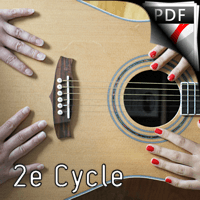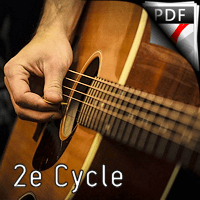Download your PDF score!
By music teachers, for their students
| Title | Author | Set | Prices | ||
|---|---|---|---|---|---|

|
Cuculi |
TRADITIONNEL ARGENTIN |
Ensemble de Guitares |
7.90€ |
|

|
Cueca |
Agustin Barrios Mangoré |
Quatuor Flûte Guitare |
7.90€ |
|

|
Nuit |
Jean-Michel Oberland |
Duo Guitare Violoncelle |
5.90€ |
|

|
Ev'rybody Wants to Be a Cat |
Al Rinker |
Ensemble de Guitares |
14.90€ |
|

|
Avril - Les Saisons |
Piotr Ilitch Tchaikovsky |
Duo Violon et Guitare |
7.90€ |
|

|
Air de Bach - BWV 1068 |
Jean-Sébastien Bach |
Ensemble de Guitares |
5.90€ |
|

|
Anaïs |
Hervé Boulet |
Trio de Guitares & Voix |
6.90€ |
|

|
Fiesta |
Michel Le Guen |
Ensemble de Guitares |
14.90€ |
|

|
Un petit matin capricieux |
Michel Le Guen |
Duo de Guitares |
5.90€ |
|

|
Suburban |
Colette Mourey |
Guitare seule |
7.90€ |
The guitar is a fretted musical instrument that usually has six strings. The sound is projected either acoustically, through a hollow wooden or plastic and wood box (for an acoustic guitar), or through an electric amplifier and speaker (for an electric guitar). It is typically played by strumming or rubbing the strings with the fingers, thumb or nails of the right hand. The guitar is a type of chordophone, traditionally constructed of wood and strung with gut, nylon or steel strings and distinguished from other chordophones by its construction and tuning. The modern guitar was preceded by the gittern, the vihuela, the Renaissance guitar and the Baroque guitar, all of which contributed to the development of the modern six-stringed instrument.
There are three main types of modern acoustic guitar: the classical guitar (nylon-stringed guitar), the steel-stringed acoustic guitar, and the so-called "jazz guitar". The sound of an acoustic guitar is produced by the vibration of the strings, amplified by the hollow body of the guitar, which acts as a resonance chamber. The classical guitar is often played as a solo instrument using a full finger-picking technique where each string is picked individually by the player's fingers, rather than being strummed. The term "finger-picking" can also refer to a particular tradition of folk, blues, bluegrass and country guitar in the United States.
Electric guitars, introduced in the 1930s, use an amplifier and speaker to make the instrument sound loud enough for performers and audiences to hear, and because they produce an electrical signal when played, they can be manipulated by the player.They can manipulate and shape the sound electronically with an equalizer and a wide variety of electronic effects units.The most commonly used are distortion (or "overdrive") and reverb. The first amplified guitars used a hollow body, but a solid wood body was eventually found to be more appropriate in the 1960s and 1970s. As with acoustic guitars, there are a number of types of electric guitars, including hollow body guitars, archtop guitars (used in jazz, blues and rockabilly guitar) and solid body guitars, which are widely used in rock music.
The loud, amplified sound and sonic power of the electric guitar played through a guitar amp played a key role in the development of blues and rock music.The loud, amplified sound and sonic power of the electric guitar played through a guitar amp have played a key role in the development of blues and rock music, both as an accompaniment instrument (riffs and chords) and as guitar solos, and in many rock sub-genres, including heavy metal and punk rock. The electric guitar has had a major influence on popular culture. The guitar is used in a wide variety of musical genres around the world. It is recognized as a primary instrument in genres such as blues, bluegrass, country, flamenco, folk, jazz, jota, mariachi, metal, punk, reggae, rock, soul, and many forms of pop.
Before the development of the electric guitar and the use of synthetic materials, a guitar was defined as an instrument with "a long neck".As an instrument with "a long fretted neck, a flat wooden top, ribs and a flat back, usually with curved sides." The term is used to refer to a number of instruments that were developed and used throughout Europe, beginning in the 12th century and later in the Americas. A 3,300-year-old stone carving of a Hittite bard playing a stringed instrument is the earliest iconographic representation of a cordophone and clay plates from Babylonia, depicting people playing an instrument that closely resembles the guitar, indicating a possible Babylonian origin for the guitar.
The modern word guitar, and its antecedents, has been applied to a wide variety of cordophones since classical times and as such causes confusion. The English word guitar, the German gitarre, and the French guitar were all taken from the Spanish guitar, which comes from the Andalusian Arabic (qitara) and the Latin cithara.
Many influences are cited as antecedents of the modern guitar. Although the development of the first "guitars" is lost in the history of medieval Spain, two instruments are commonly citeds as their most influential predecessors, the European lute and its cousin, the four-stringed oud; the latter was brought to Iberia by the Moors in the eighth century.
At least two instruments called "guitars" were in use in Spain in 1200: the Latin guitar (Latin guitar) and the Moriscan guitar (Moorish guitar). The morisca guitar had a rounded back, a wide fingerboard and several sound holes. The Latina guitar had a single sound hole and a narrower neck. By the fourteenth century, the terms "moresca" or "morisca" and "latina" had been dropped, and these two cordophones were simply called guitars.
The Spanish vihuela, known in Italian as the "viole da mano," a guitar instrument of the fifteenth and sixteenth centuries, is widely regarded as the most important influence in the development of the baroque guitar. In the sixteenth century, the construction of the vihuela had more in common with the modern guitar, with its one-piece curved ribs, than with viols, and more like a larger version of contemporary four-string guitars. The vihuela enjoyed a relatively short period of popularity in Spain and Italy at a time when the lute dominated elsewhere in Europe; the last published music for the instrument appeared in 1576.
Meanwhile, the five-course baroque guitar, which has been documented in Spain from the mid-sixteenth century, enjoyed great popularity, especially in Spain, Italy, and France from the late sixteenth to the mid-eighteenth century. In Portugal, the word viola referred to the guitar, as guitarra meant "Portuguese guitar," a variety of cittern.
